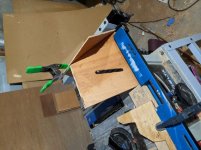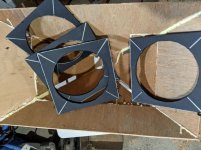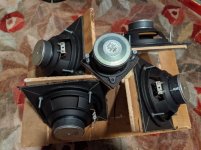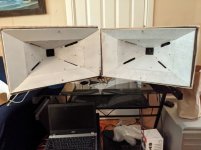There's been a lot of fun discussions on these forums, but it was time for me to make some speakers that:
What I've created I can't take credit for - it's thanks to the experience, genius and willingness to share on these forums that this pair of speakers came about:
So what I've ended up here is a 2-way system, with each speaker using 4 of the Parts-Express 6.5" Polycone woofers, and one FaitalPRO 3FE22 at the apex of the horn. I've chosen a 500Hz crossover between them, and I have initially opted to add a 0.4 millisecond delay on the FaitalPRO driver for coherence.
The horn size I chose was mostly dependent on having panels large enough to mount the woofers, so I went with a 425Hz pattern control frequency at 90 degree horizontal, by 60 degree vertical coverage angles.
This project was by far one of the most complicated I've personally undertaken - lots of mitering, and making sure I had right-angle jigs set up for gluing the panels together. Given that I'd taken the 'pinwheel' approach for mounting the woofers (thanks Art), I couldn't follow the CoSyne spreadsheet to the letter.
Apart from the jigs, I made good use of duct tape. It's an amazing clamp when nothing else makes sense!
I also used Gorilla glue. The foaming nature of the glue filled some gaps created by my inaccuracies, and usually cured within a couple of hours, meaning that I could repeatedly go back to work on the horns in a single day.
The enclosures were based on the ideas from xrk971's rear chambers for the Trynergy - 11 litres per pair of drivers if I remember correctly. So, using the measurements from the spreadsheet I put the dimensions into HornResp, which calculated the volume of the horn, and so I aimed to add 22 litres to that, within practical means. I think the difference was more like 25 litres in the end, so not too bad.
I stuffed the back of the box with some food packaging - it looks like fibreglass, but it's made from recycled boxes (my wife receives it as packaging from a vegetable delivery service), so it was easy to handle, easy to staple in, and did a good job of deadening the walls of the box.
The wood was free. I found some pieces of 1/2" plywood, 1/2" chipboard from what looked like the back of a cheap cabinet (the staples were still in there), and some 1" siding! None of it was straight, so I made everything straight as best as I could while clamping and gluing.
Foam core board also makes an appearance in this design, as I needed to create gaskets to separate the drivers from the wood panels. It worked perfectly.
For the wiring, I used a good 16AWG speaker wire, and crimped on spade connectors, in case I ever needed to swap anything out, though this is probably just overkill. I have those 4-gang spring clamps that you see on the back of the lower-end amplifiers to use for bi-amping.
I've been impressed with the Synergy designs that I've built in the past, but this experience was completely different! A completed enclosure, in a stereo pair - wow!
"Wow" is an understatement, so I'll try to explain what that really means
I'm going to be setting them up with subs soon, and I may play with something like REW and FIR filtering to get them to match the space. From what I'm hearing, it's not going to take much to make them sound even better
Thanks for reading! I will be working on another pair soon, but they will be of a slightly different design, with the intent to be done more precisely. The boxes for this pair were rough, but I was really attempting to focus on making the horns as precise as I could!
- Housed some of the speakers I have
- Were a complete, enclosed system
What I've created I can't take credit for - it's thanks to the experience, genius and willingness to share on these forums that this pair of speakers came about:
- xrk971 - for the Trynergy design, and the microTrynergy
- bwaslo - for the absolutely amazing spreadsheet he's created that detail the panels for the CoSyne speaker design
- weltersys - for the SynTripP design
- HenrikEnquist - for the design of CamillaDSP
- David McBean - for the invaluable HornResp tool
- Tom Danley and Danley Sound Labs for their amazing designs and help throughout the community over the years
So what I've ended up here is a 2-way system, with each speaker using 4 of the Parts-Express 6.5" Polycone woofers, and one FaitalPRO 3FE22 at the apex of the horn. I've chosen a 500Hz crossover between them, and I have initially opted to add a 0.4 millisecond delay on the FaitalPRO driver for coherence.
The horn size I chose was mostly dependent on having panels large enough to mount the woofers, so I went with a 425Hz pattern control frequency at 90 degree horizontal, by 60 degree vertical coverage angles.
This project was by far one of the most complicated I've personally undertaken - lots of mitering, and making sure I had right-angle jigs set up for gluing the panels together. Given that I'd taken the 'pinwheel' approach for mounting the woofers (thanks Art), I couldn't follow the CoSyne spreadsheet to the letter.
Apart from the jigs, I made good use of duct tape. It's an amazing clamp when nothing else makes sense!
I also used Gorilla glue. The foaming nature of the glue filled some gaps created by my inaccuracies, and usually cured within a couple of hours, meaning that I could repeatedly go back to work on the horns in a single day.
The enclosures were based on the ideas from xrk971's rear chambers for the Trynergy - 11 litres per pair of drivers if I remember correctly. So, using the measurements from the spreadsheet I put the dimensions into HornResp, which calculated the volume of the horn, and so I aimed to add 22 litres to that, within practical means. I think the difference was more like 25 litres in the end, so not too bad.
I stuffed the back of the box with some food packaging - it looks like fibreglass, but it's made from recycled boxes (my wife receives it as packaging from a vegetable delivery service), so it was easy to handle, easy to staple in, and did a good job of deadening the walls of the box.
The wood was free. I found some pieces of 1/2" plywood, 1/2" chipboard from what looked like the back of a cheap cabinet (the staples were still in there), and some 1" siding! None of it was straight, so I made everything straight as best as I could while clamping and gluing.
Foam core board also makes an appearance in this design, as I needed to create gaskets to separate the drivers from the wood panels. It worked perfectly.
For the wiring, I used a good 16AWG speaker wire, and crimped on spade connectors, in case I ever needed to swap anything out, though this is probably just overkill. I have those 4-gang spring clamps that you see on the back of the lower-end amplifiers to use for bi-amping.
I've been impressed with the Synergy designs that I've built in the past, but this experience was completely different! A completed enclosure, in a stereo pair - wow!
"Wow" is an understatement, so I'll try to explain what that really means
- These speakers are pretty much full range. There's no need for a sub unless you're trying to cover lower than, say 70Hz (not measured, just guessing) really well
- The point source effect is astounding. Like Danley Sound Labs have mentioned in their YouTube videos, the speakers just disappear - it makes you wonder why the box is so big, because all of the sound's coming from the dead centre of the horn! I have them set up at different heights at the moment, and it's easy to tell that one is higher than the other!
- Because of this, the stereo imaging is absolutely wonderful
- These speakers are the closest thing to headphones that I've heard
I'm going to be setting them up with subs soon, and I may play with something like REW and FIR filtering to get them to match the space. From what I'm hearing, it's not going to take much to make them sound even better
Thanks for reading! I will be working on another pair soon, but they will be of a slightly different design, with the intent to be done more precisely. The boxes for this pair were rough, but I was really attempting to focus on making the horns as precise as I could!
Attachments
Last edited:
Cool project! 
I don't really understand the pinwheel arrangement of the woofers. Can you post more pics?
Last year I built a pair conical horns from foamcore based on Bill Waslow's spreadsheet. I used the Faital 3" at he apex. Just the single driver, but they did do some of the amazing imaging for which the Synergy are famous.

I don't really understand the pinwheel arrangement of the woofers. Can you post more pics?
Last year I built a pair conical horns from foamcore based on Bill Waslow's spreadsheet. I used the Faital 3" at he apex. Just the single driver, but they did do some of the amazing imaging for which the Synergy are famous.
Hi Unahm:
Super work and great repurposing scrap materials. I like the fact that you are using the $5 Dayton 6.5in woofers from the Trynergy. 3FE22 for the full-range is awesome. Looking forward to seeing more. Great idea with the pinwheel arrangement - let’s you fit the 4 woofers on each panel nicely.

@Pooh:
I think this design is sort taking after the Trynergy, this is a FAST (wide band) design, meaning, the apex driver handles the telephone band from circa 500Hz and above. A CD can’t go that low and would require mid range injection ports oh so close to the thread of the apex.
Super work and great repurposing scrap materials. I like the fact that you are using the $5 Dayton 6.5in woofers from the Trynergy. 3FE22 for the full-range is awesome. Looking forward to seeing more. Great idea with the pinwheel arrangement - let’s you fit the 4 woofers on each panel nicely.

@Pooh:
So you are saying those PE 6.5" go down to 70 cycles in that little horn?
Why did you use a cone and not a compression driver with a phase plug?
I think this design is sort taking after the Trynergy, this is a FAST (wide band) design, meaning, the apex driver handles the telephone band from circa 500Hz and above. A CD can’t go that low and would require mid range injection ports oh so close to the thread of the apex.
Last edited:
Any response plots to share? Before and after eq would be interesting.
Will do, William! I've been using them for the past couple of days as studio monitors just with crossovers and the delay, and they're really good - it's really easy to separate individual instrument/vocal tracks when mixing, so that should hopefully aid my final mixes
Cool project!
I don't really understand the pinwheel arrangement of the woofers. Can you post more pics?
Last year I built a pair conical horns from foamcore based on Bill Waslow's spreadsheet. I used the Faital 3" at he apex. Just the single driver, but they did do some of the amazing imaging for which the Synergy are famous.
Art's (weltersys) suggestion of using the pinwheel arrangement was to keep the injection ports as centered as possible to the speaker cone, so that it wouldn't cause the cone to 'rock' at high excursion levels. Given that this is a Hi-Fi application I doubt I'll have that issue, but it was a good principle to follow
He most recently documented it here
Hi Unahm:
Super work and great repurposing scrap materials. I like the fact that you are using the $5 Dayton 6.5in woofers from the Trynergy. 3FE22 for the full-range is awesome. Looking forward to seeing more. Great idea with the pinwheel arrangement - let’s you fit the 4 woofers on each panel nicely.
@Pooh:
I think this design is sort taking after the Trynergy, this is a FAST (wide band) design, meaning, the apex driver handles the telephone band from circa 500Hz and above. A CD can’t go that low and would require mid range injection ports oh so close to the thread of the apex.
Definitely, your Trynergy and uTrynergy designs were the basis of this! I just wanted a challenge with wood, mitering and stuff like that
This might be an excellent inspiration for this kind of synergy F.A.S.T design.
H.A.V.O.F.A.S.T. Studio-H.A.V.O.F.A.S.T. Stu
H.A.V.O.F.A.S.T. Studio-H.A.V.O.F.A.S.T. Stu
Are you using CamillaDSP for your crossover?
Yes, though I've only used it for crossovers at the moment.
Yes, though I've only used it for crossovers at the moment.
Oops, that wasn't a very good answer
I haven't measured them, but I should! The computer I was using for the DSP died on me, but I could measure the raw driver response just to see what would need to be correcteddid you ever measure/tune these? I'm interested as it's using cheap drivers that are actually available.
I can take some!Interesting i like it. what are the dimensions of each box and do you have pics of the rear..?
I'll also do some pre-eq measurement this week
I'm almost finished making a similar pair of two way synergy using 3fe22 and faitalpro 6fe100.
60x40 with built in Bluetooth class D amps in.
The little faitals really shine horn loaded, I used the ferrite version during some of my testing and the neo versions do seem to go higher, over 2k. I'm experimenting with passive crossovers ATM, but I think they will ultimately benefit from a minidsp, the 3fe22 do sound great but the fr isn't all that flat, even excluding the 10+dB drop as the horn loading drops off.
Adding a compression driver of good sensitivity from ~1500hz would be a nice way to keep efficiency high.
Even with only 2 X 6 inch drivers a side I'm getting -3db in the 60s. Have the ports to add 2 more per horn if I think the £88 is worth it. The port size makes such a dramatic effect on bass extension and distortion.


60x40 with built in Bluetooth class D amps in.
The little faitals really shine horn loaded, I used the ferrite version during some of my testing and the neo versions do seem to go higher, over 2k. I'm experimenting with passive crossovers ATM, but I think they will ultimately benefit from a minidsp, the 3fe22 do sound great but the fr isn't all that flat, even excluding the 10+dB drop as the horn loading drops off.
Adding a compression driver of good sensitivity from ~1500hz would be a nice way to keep efficiency high.
Even with only 2 X 6 inch drivers a side I'm getting -3db in the 60s. Have the ports to add 2 more per horn if I think the £88 is worth it. The port size makes such a dramatic effect on bass extension and distortion.
- Home
- Loudspeakers
- Multi-Way
- 2-way Synergy horn



